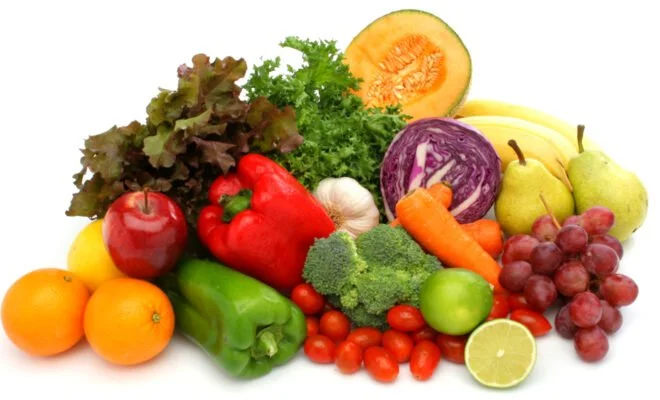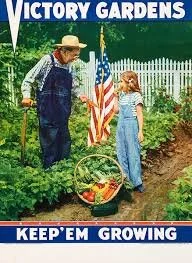TINY OFF-GRID HOUSE SUSTAINABLE GARDENING
Image courtesy of IStock
VICTORY GARDENS:
Victory Gardens, aka War Gardens, flourished in the United States during World War I & II in an effort to prevent food shortages during war time. The Victory Gardens would supplement food for civilians, due to government imposed food rationing, by encouraging families to plant their own vegetables, fruits and herbs gardens in available private and public plots of land: front yards, back yards, rooftops, fire escapes, city parks, food forest . . . canning and preserves of produce were also encouraged.
Image courtesy of Poster-Rama
The program was so successful that 20 million community gardens produced close to 40% of the U.S. fresh vegetables during WWII. The momentum quickly died after the war ended and industry shifted away from war time production to commercial production for the consumer market. The former war time chemical industry needed a new market for their repurposed war time commodities and started promoting front lawns full of green grass managed with chemical herbicides, fertilizers and pesticides repurposed from their stockpiles of military surplus weapons grade chemicals. Ammonium nitrate repurposed itself from being the primary chemical ingredient in explosives & bombs to being used as a synthetic fertilizer to help plants grow. Ammonium nitrate is derived from natural gas synthesized through the Habor-Bosch method and converted in to Ammonia, then combined with CO₂ to create Urea fertilizer. Edible, medicinal and nutritious plants like dandelions were criminalized and branded as weeds requiring the eradication of theses felons from pure grass lawns with—toxic—chemical herbicides.
The opulence and maintenance now required of American front lawns seems to have been inspired by European royalty & elites practice of displaying their wealth & abundance by misappropriating the true potential of arable land with nonproductive decorative flower gardens & landscaping.
Image courtesy of The Home Depot
RAISED GARDEN BEDS
If access to ground soil is not available because it is covered by concrete or maybe the soil is contaminated, a raised garden bed is a viable option to still have an organic garden.
A raised garden bed can be any shape or size. The ideal height depends on a height that’s comfortable for the gardener to prevent lower-back strain while gardening.
The Hügelkultur (Hill culture) method is a very inexpensive and sustainable way of filling a raised garden bed. The method repurposes salvaged wooden logs and branches, along with green and brown matter to fill the bottom layer. The gaps between the wood should be tightly filled with compost, wood chips and soil to make less habitable for rodents. Then the top layer is filled with soil. As the large mass of wooden logs and branches decay they will nourish the soil and slowly release heat extending the growing season for the plants and vegetable above. The decaying wooden mass also acts as a sponge soaking moisture for slow release. The best time to start a raised bed is in the Fall to be ready for Spring planting.
However, there are some species of wood to avoid for filling the base of the raised bed garden. For instance, Eucalyptus, Black Walnut and Pine contain allopathic chemicals that can inhibit plant growth.
The same allopathic concerns occur with the materials used to build the walls of the raised garden bed. Also, there are rot & corrosion concerns with the materials constructing the frame of the raised garden bed. A recommendation is Hemlock which is a popular soft wood used for framing, since the wood is nonallopathic and rot resistant.
MANAGING FOOD WASTE:
According to the United States Food and Drug Administration (FDA) “in the U.S., food waste is estimated between 30 - 40 % of the food supply.” It is common practice for farmers and food distributers to discarded fruits and vegetables before selling because of cosmetic defects the commercial food industry believes would be unappealing to consumers. The U.S. Environmental Protection Agency (EPA) “estimates that more food reaches landfills and incinerators than any other single material in our everyday trash, constituting 22% of municipal waste.” “Organic waste, mostly food, is the second biggest component of landfills, and landfills are the third largest source of methane emissions. Methane is a major factor in global warming because it is so effective at absorbing the sun’s heat, which warms the atmosphere.”
An alternative to food waste reaching landfills is composting which is a closed loop way to sustainably keep plant based kitchen food scraps and garden waste out of anaerobic municipal landfills and back in to the garden. Compost nurtures the soil by facilitating the growth of beneficial microbes in the soil, provides the slow “stored” release of nutrients—unlike the rapid release of synthetic fertilizers— improves the soil water holding capacity, improves soil aeration and promotes soil structure (tilth).
According to the Brooklyn Botanic Garden “Easy Compost - Compost is the product of the controlled ‘aerobic’ decomposition of organic matter by microbes and other organisms.” The key word here is aerobic; meaning the decomposition process of organic and inorganic matter involves microbes and worms (vermicomposting) that use oxygen, as apposed to anaerobic decomposition found in most major municipal landfills which does not. Worms also help decompose organic and inorganic matter creating nutrients in the form of their excrement called worm casting or vermicast. Also, worms help aerate the soil when they create tunnels. The worms can consume most organic matter that was once living. But worms may shy away from fermented, spicy or highly acidic foods.
Both aerobic and anaerobic forms have their purposes. Aerobic, aka hot, composting generates carbon dioxide (CO2),which is absorbed by vegetation. A compost thermometer can help display ideal temperatures which can range 110° F - 160° F; enough to neutralize harmful bacteria, seeds and pathogens. Other byproducts of aerobic composting are moisture and heat. The latter helps to neutralize harmful bacteria and pathogens. Aerobic composting can be performed above ground and requires periodic rotation of the soil for aeration. Ideal temperatures range < 90° F Anaerobic composting requires little effort and maintenance. However, it may take from 2 to 3 years until the pile has matured to ready for use compost. It occurs underground in trenches or landfills and covered over with soil. Little heat is generated which does not neutralize harmful bacteria or pathogens. A byproduct of anaerobic composting is methane gas. Methane (CH4) gas is considered a greenhouse gas. Methane is 100 times more potent than carbon dioxide at trapping the suns heat subsequently warming the Earth.
If your compost has a pungent odor like rotten eggs or ammonia it may have too much moisture or require rotation. If your compost attracts vermin or other scavengers it maybe due to the introduction of rancid meat, bones, fats, fermented products or dairy products. Also, feces from animal companions should not be introduced in to the compost because it may not be capable of neutralizing any potential harmful bacteria or pathogens found in their feces.
For purposes of a Tiny House, Vermicomposting maybe the best option. Vermicomposting can take place in a 10 to 15 gallon plastic container that can handle up to 5 pounds of kitchen waste weekly. A vermicomposting container contains soil, organic materials, moisture, ventilation and self reproducing E. andrei or red wigglers (Eisenia fetida) worms. Red worms (Lumbricus rubellus) are an invasive species in North America forest and should not be used. The invasive species of worms reduce the protective layer of decomposing leaf litter mulch covering the forest floor which provides an ecosystem for insects and microorganisms and allows the soil to lose moisture. Red wigglers worms eat half their weight in food waste daily. The worms do not like bright light and would borrow in to the soil when exposed to light. Vermicomposting is ideal for a Tiny Off-Grid House because the container can fit easily under a dark kitchen sink; using unused indoor floor space—compared to hot and cold composting which requires use of outdoor land. Vermicomposting provides a faster conversion of kitchen waste into humus (A rich nutrient filled soil matter not to be confused with the food Hummus). The final product, worm casting inoculates the soil it is deposited in with slow release nutrients and beneficial microorganisms that helps plants grow and fight off diseases.
The major benefits of vermiculture is that it produces more nutrient rich compost and beneficial soil microorganisms than conventional (hot/cold) composting. Since the worms have to avoid the cold the container benefits being indoors. Even if a conventional compost pile attracts worms the extreme temperatures of a hot compost and the cold weather exposure of a cold compost will harm the worms. Unlike hot composting, Vermicomposting does not generate enough heat to neutralize pathogens. Uninvited fruit flies may invade the compost; if so, passing a layer of soil or moist shredded newspaper can prevent these nuisances.
WHAT TO ADD IN A COMPOST:
Organic materials
Fruits and vegetables (Carbon, Brown, Dry)
Flowers and plants (Carbon)
Egg and nut shells (Carbon)
Leaves (Carbon)
Grass clippings (Nitrogen, Green, Wet)
Wood chips, chopped twigs & sawdust (Carbon)
Dried leaves (Nitrogen)
Moist cardboard (Nitrogen)
Straw (Nitrogen)
Moist shredded—nonglossy—newspaper (Nitrogen)
Coffee grounds and tea (Remove mesh or plastic tea bags) (Nitrogen)
WHAT NOT TO ADD IN A COMPOST:
Nonbiodegradible: Plastic, metal, glass, ceramics, stone . . .
Meat, bones, fats,
Cookings oil and grease
Acidic foods: Lemons, Lime, oranges . . .
Spicy or hot foods: Hot peppers, onions, garlic,
Dairy: Milk, cheese, butter . . .
Glossy, colored ink or wax paper
Poisonous plants: Poison ivy
Grass clippings or plants treated with pesticides
Soap
Dog & cat feces
In 2010, the Belgium town of Mouscron gave 50 free pairs of chickens with coops to urban residents whom had the garden space to accommodate them; along with a stipulation not to consume the chickens for at least 2 years. The program has since expanded to other Belgium towns.
The Chickens helped dispose of household kitchen scraps and eliminate insect garden pest. It has been reported, Chickens can process about 50kg of household food and garden waste annually. As the Chickens peck and claw the soil for insects and grubs the soil is turned and aerated. As a bonus, the families have access to nutritional organic eggs; with little, to no, cost of investment.
Growing fruits and vegetables in a Victory Garden complements Tiny Off-Grid sustainable living and getting closer to nature. Even if an urban Victory Garden may only provide a small part of your daily nutrition it can help promote better nutrition and self-sufficiency for the family.
Please share your thoughts or experiences in the Comments section below.


